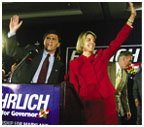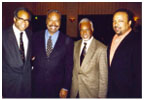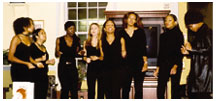December 4, 2002: Notebook
FACULTY
FILE
Fueling up the future
University asks for dismissal of Robertson lawsuit

Fueling up the future
“Fill ’er up!” may take on a new meaning down the road as car-makers turn to gasoline alternatives to make their vehicles go.
Chemistry professor Andrew Bocarsly and his lab partners have taken several steps toward that future, with fuel-cell experiments that have attracted the attention of automobile giants such as Toyota.
A fuel cell combines hydrogen with oxygen to produce energy in the form of electricity. Bocarsly’s project, funded by the Department of Energy, uses fuel cells the size of microcassettes.
Fuel cells are already being used in conjunction with gasoline to power some automobiles and in demonstration buses in Chicago and Vancouver. Bocarsly believes that within 10 years there will be even wider use, as hydrogen finds greater acceptance as a fuel source and cleaner ways to produce hydrogen are discovered.
Bocarsly and his team work with high-temperature proton exchange membranes (PEM), which operate between 150 and 200 degrees Fahrenheit. PEM is one of six technologies in use as the race to find the most efficient and high-performing fuel cells takes place in corporate and university laboratories around the world.
The Princeton team already has filed two patents, says Bocarsly, who has been at Princeton since 1980. He says his fuel-cell research is different from anything he has been involved in because it is so close to the marketplace.
“I’ve never before had companies knocking
on my door saying, ‘Tell us what you’re doing,’” he
says. “It’s scary because I have to be concerned that all my
research might suddenly be for naught because some company has put 500
researchers on the project — and I lose.” ![]()
By A.D.

A.B.P.A. marks 30 years of existence, support, and cohesion
By Theola Labbé ’96
|
At the 30th-anniversary celebration of the Association of Black Princeton Alumni on October 26, alumni reconnected, including (from left) keynote speaker Randall Kennedy ’77, A.B.P.A. board member Sergio Sotolongo ’77, university trustee Henry H. Kennedy ’70, and A.B.P.A. president Kenneth Bruce ’83.
Culturally Yours, a student a cappella group, performed at the A.B.P.A. welcoming dinner, held at the Carl Fields Center.
|
The night of the Harvard-Princeton football game on October 26, dozens of African-American Princeton alumni gathered at a local hotel in Princeton, where they sipped cocktails and greeted old friends with spirited hugs. It was the social hour before the 30th-anniversary dinner for the Association of Black Princeton Alumni, with Harvard Law School professor Randall L. Kennedy ’77 as the featured speaker.
Kennedy, whose recent book Nigger looks at the history of the racially charged word, spoke that evening about the accomplishments of James Weldon Johnson, N.A.A.C.P. leader in the early 1900s and author of the song “Lift Every Voice and Sing.”
“I wanted to be part of the celebration,” Kennedy said. “It’s the Association of Black Princeton Alumni, it’s part of the Princeton family.” A.B.P.A.’s celebration also included a panel on student recruitment and a talk by Professor of Philosophy K. Anthony Appiah, who joined the Princeton faculty this year.
This particular part of the Princeton family was begun three decades ago by seven African-American alumni looking to preserve and build a black Princeton legacy. “We wanted to get and build an organization that all of Princeton could be proud of,” says Jerome Davis ’71, an A.B.P.A. cofounder, whose daughter Kamille is a sophomore.
Out of Princeton’s 2,400 black alumni, or 4 percent of the total undergraduate alumni body, about 450 are active in A.B.P.A., according to Kenneth Bruce ’83, the association’s president. African-American students become automatic members upon graduation.
A.B.P.A. uses an electronic listserve to share with its members notices of job openings, news from the university, and items of note. To develop relationships with black undergraduates, A.B.P.A. holds career nights and mixers, and chooses an African-American student each year to receive a $1,000 scholarship and $500 book stipend.
Since 1981, A.B.P.A. has given awards at Reunions to black alumni who exemplify the university’s motto, “Princeton in the nation’s service.” President Kenneth Bruce says it is the group’s largest and most important
activity. “The reason the awards were created was to recognize alumni within our community we felt were doing substantial things that might not be recognized in the overall community,” he says. (A list of the award winners is located on A.B.P.A.’s Web site, http://alumni. princeton.edu/~abpa/awards.html.)
The awards also give black alumni, many of whom do not
feel the same connection to Princeton as white alumni, a reason to come
back to the university, says board member Tshaka Cunningham ’96.
“Students need to see that we have a long tradition now, a 30-year
tradition,” he says. ![]()
Theola Labbé ’96 is a metro reporter for the Washington Post.

 Election-day
Princetonians
Election-day
Princetonians
Photo: Robert Ehrlich ’79 (getty images/alex wong)
Last month was a good one for Tigers on the campaign trail.
Former Princeton football captain Robert Ehrlich ’79 became the first Republican to be elected governor of Maryland in 36 years, beating Lieutenant Governor Kathleen Kennedy Townsend.
Ohio Governor Bob Taft *67 handily won a second term in the statehouse in Columbus. (Taft’s re-election came 90 years to the day after his great-grandfather, President William Howard Taft, lost his re-election campaign to President Woodrow Wilson 1879.)
And Jim Leach ’64, who arrived in Congress in 1976, held onto his seat in Iowa, where his district had been redrawn.
The biggest impact a Princetonian made on the national level may have been that of Tennessee Senator Bill Frist ’74, who served as chairman of the National Republican Senatorial Committee. Frist, who has been mentioned as a possible running mate for President Bush in 2004 and a potential presidential candidate in 2008, helped select G.O.P. candidates, raised campaign funds, and played a major role as the Republican party regained a majority in the Senate.
“It was a very significant win for him as well,” says Nan Wells, director of Princeton’s Office of Government Affairs in Washington. “It adds to his luster as a fast-rising star in the Republican Party.”
Princeton alumni lost two big races, however. In Vermont, Lieutenant Governor Doug Racine ’74, a Democrat, conceded a tight race to Republican James Douglass even though, under Vermont law, if a candidate does not receive 50 percent of the vote, the Vermont General Assembly selects the governor when it reconvenes in January. Douglass received 45 percent of the vote to Racine’s 42 percent. In California, Republican Bill Van DeWeghe ’83 lost in his bid for Congress.
A noteworthy Senate race in Iowa pitted a pair
of Princeton parents against each other as Democrat Tom Harkin p’98
p’03 beat Republican Congressman Greg Ganske p’02. ![]()
By. A.D

Attorneys representing the university, President Tilghman, and three alumni on the board of the Robertson Foundation filed a motion in New Jersey Superior Court on November 4 to dismiss the lawsuit brought by William Robertson ’72 and other members of his family this summer.
The motion argues that Tilghman, Peter Wendell ’72, John Kenefick ’43, and John Sherrerd ’52 did not have enough time to respond to the issues Robertson raised regarding management of the Robertson Foundation before he filed a lawsuit in July. According to the defendants’ lawyers, members of a foundation’s board of trustees are required by law to give the board an opportunity to investigate and resolve potential problems before going to the courts.
Doug Eakeley, an attorney for the university, said Tilghman and the other defendants were in the process of responding to requests Robertson had made at an April 16 board meeting when the lawsuit was filed. Eakeley also asked that the lawsuit be thrown out because, as members of the foundation’s board for nearly 20 years, Robertson and his cousin Robert Halligan *73 “either approved of or acquiesced in the allegedly wrongful conduct.”
Eakeley expects that the courts will decide on the motion to dismiss early next year.
Robertson’s parents, Charles ’26 and Marie, established the foundation in 1961 with a $35-million donation to Princeton designed to fund the graduate program at the Woodrow Wilson School to train public servants, especially those focused on international affairs. That donation has grown into the foundation’s current $560-million endowment.
The lawsuit accuses the university-appointed foundation
trustees of trying to transfer control of the foundation’s assets
to the Princeton University Investment Company, Princo, and to commingle
those assets with the university’s own endowment. It also alleges
that the Woodrow Wilson School has not fulfilled its mission as mandated
by the donors. The university has denied those allegations. ![]()
By A.D.

Ansley Johnson Coale ’39 *47, the William Church Osborn Professor of Public Affairs and Professor of Economics, emeritus, died November 5. He was 85. Coale worked at the Office of Population Research, serving as director from 1959 to 1975. He published more than 125 books and articles on a wide variety of demographic topics. His first major work was Population Growth and Economic Development in Low-Income Countries (1958), cowritten with Edgar Hoover. The results, which showed that slowing population growth could enhance economic development, had a major impact on public policy and set the research agenda in this field.
Chang-Lin Tien *59, a university trustee from 1991 to
1995 and former chancellor of the University of California—Berkeley,
died October 29 at age 67. An impoverished immigrant
from China in 1949, Tien eventually earned two master’s degrees and
a doctorate in mechanical engineering at Princeton. He began his academic
career at Berkeley in 1959 as an assistant professor and rose through
the ranks, serving as chancellor from 1990 to 1997. In 2000, Tien received
Princeton’s James Madison Medal, given each year to a distinguished
alumnus or alumna of the Graduate School. As a scientist, Tien made extensive
contributions in understanding thermal radiation and insulation, and microscale
thermal phenomena. He authored more than 300 research journal and monograph
articles, 16 edited volumes, and one book.
![]()


